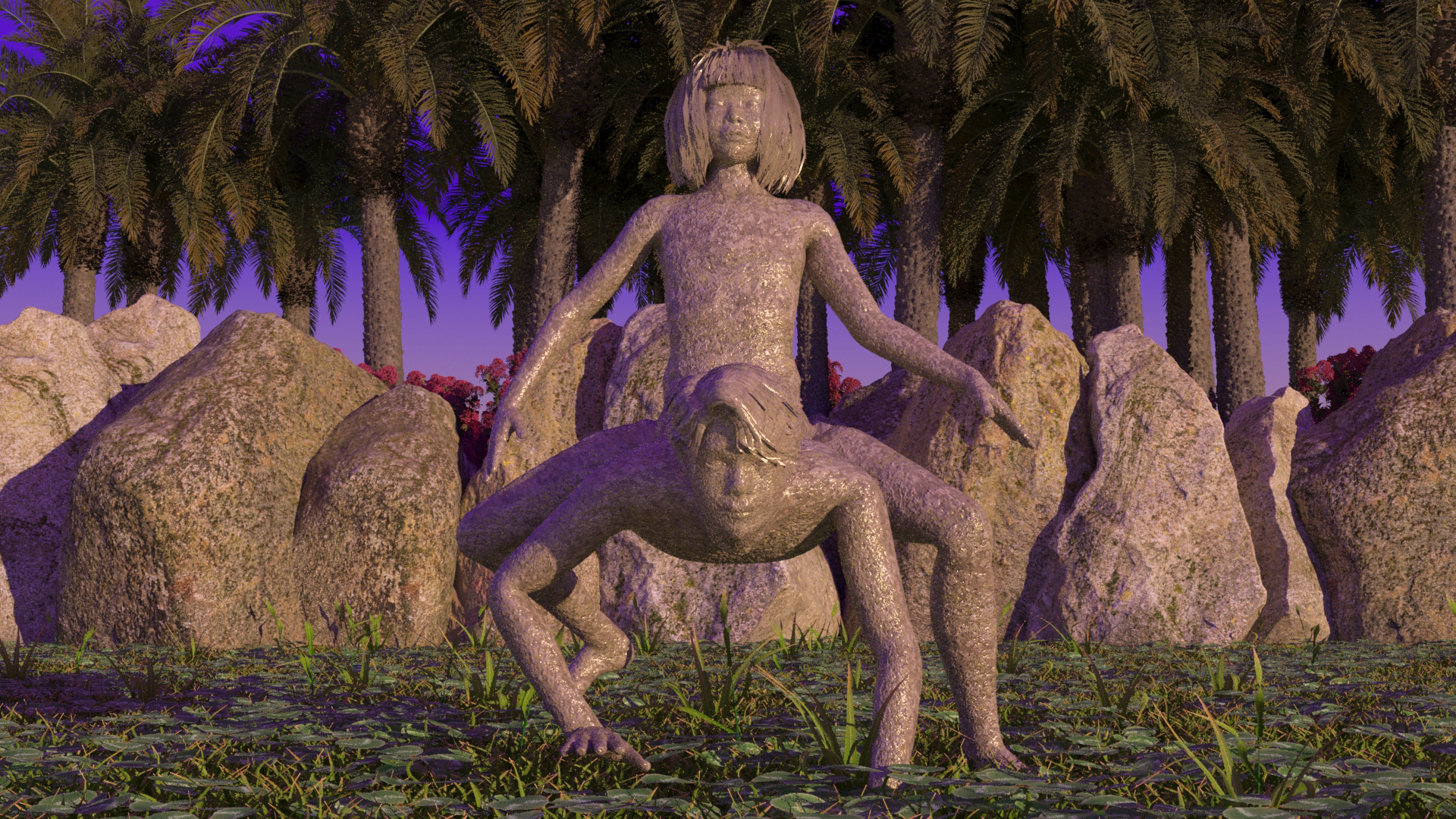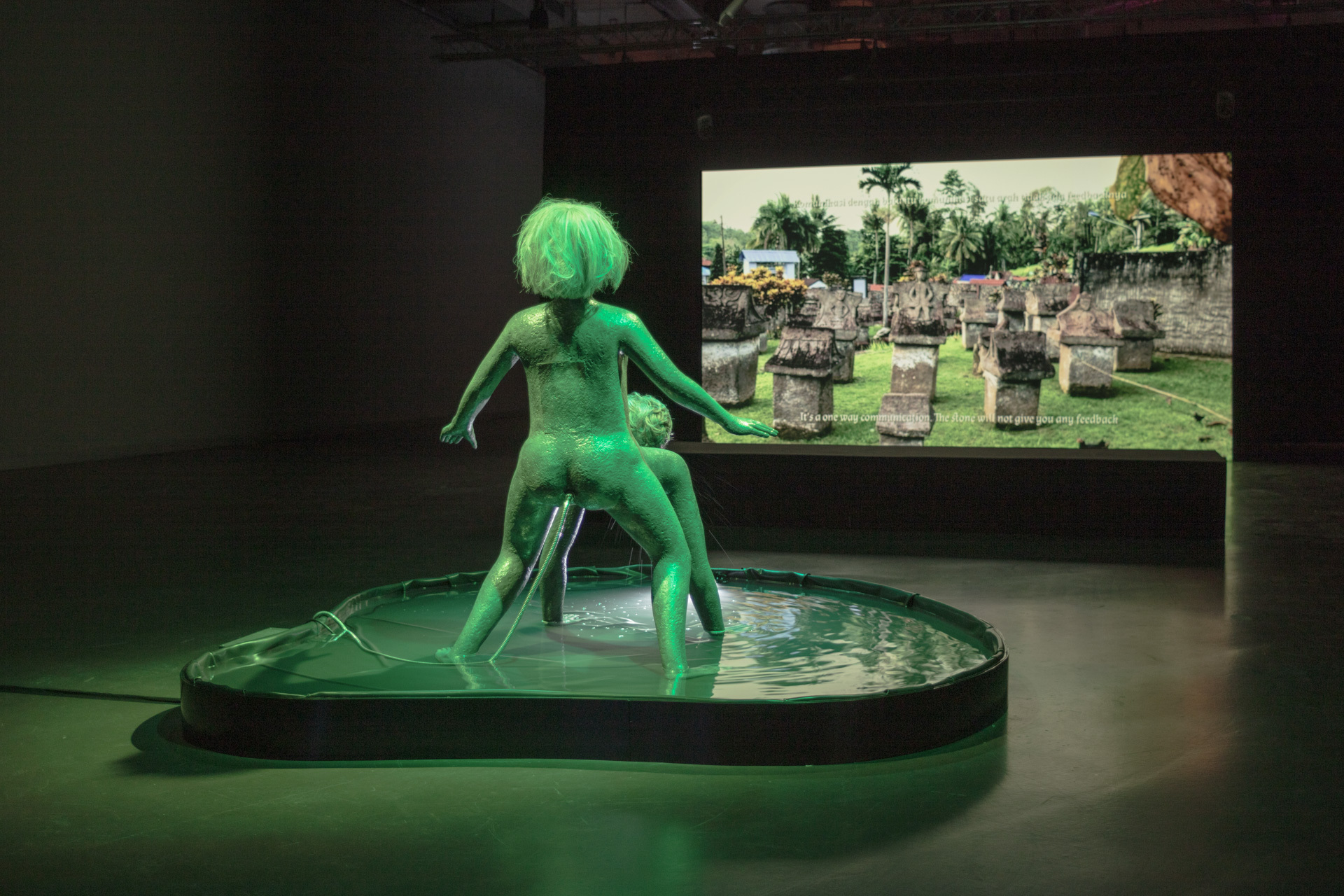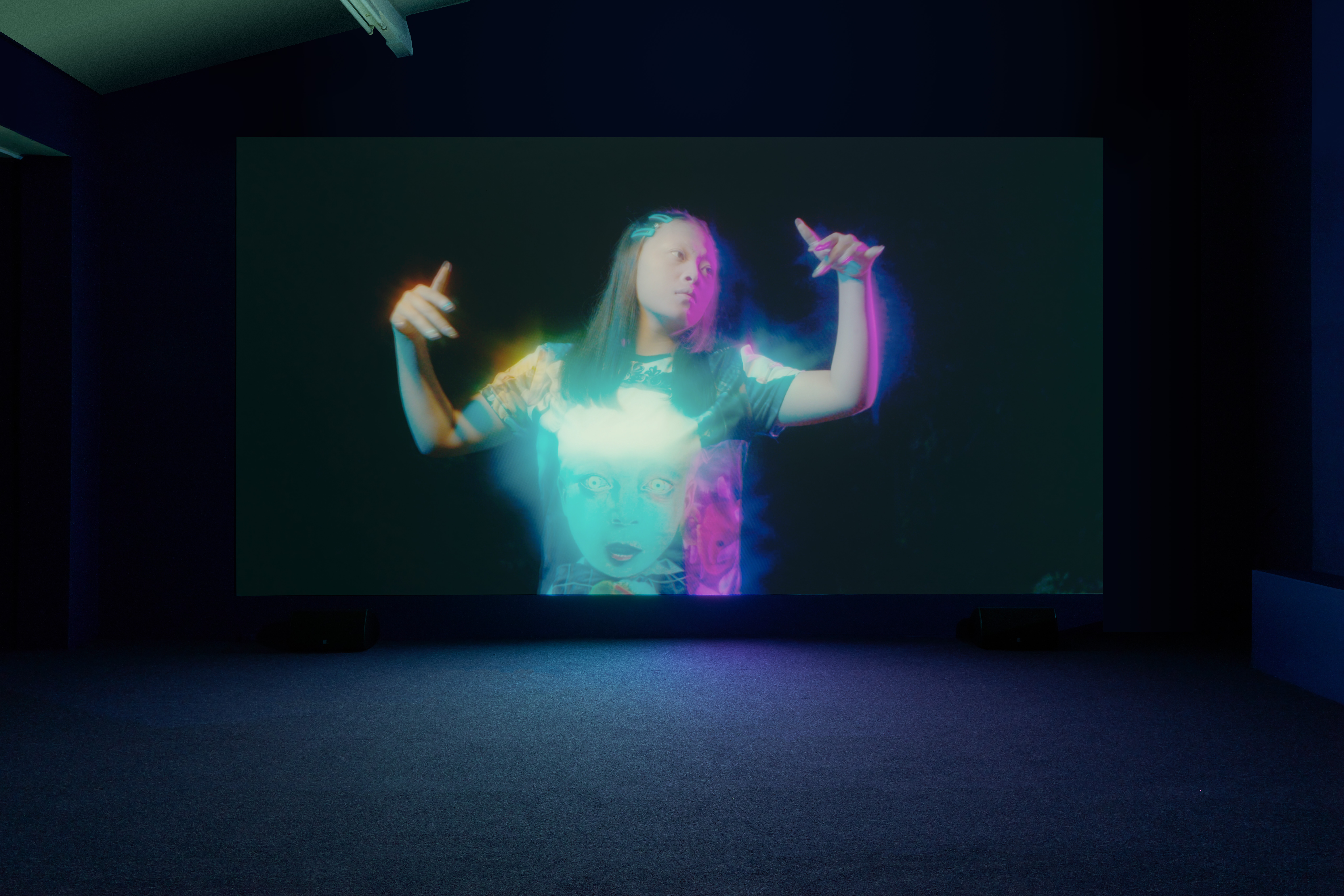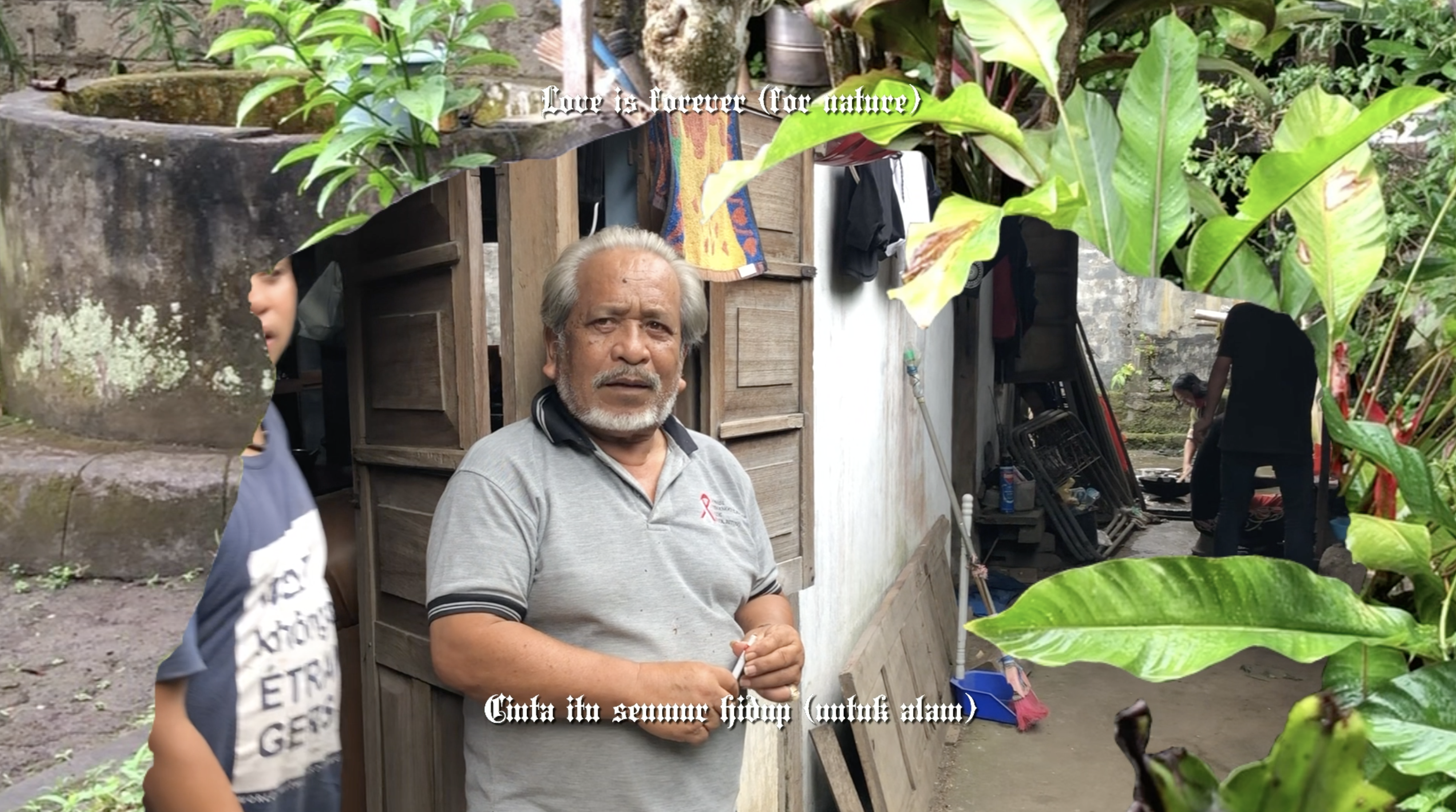Slow
Conversations
Natasha Tontey is an interdisciplinary artist. Her artistic practice predominantly explores the fictional accounts of the history and myths surrounding ‘manufactured fear.’ In her practice, she observes any possibilities of other futures that are projected not from the perspective of major and established institutions, but a subtle and personal struggle of the outcasted entities and beings. Her recent exhibitions include a solo show at Auto Italia, London, UK (2022). And selected group shows at Singapore Biennale 2022; GHOST;2565, Bangkok (2022); transmediale 2021; Other Futures, Amsterdam (2021). In 2020, she received the HASH Award from the ZKM, Center for Art and Media Karlsruhe and Akademie Schloss-Solitude. She is a fellow for Human Machine of the Junge Akademie at Akademie der Künste Berlin 2021-2023.
Filed under: animation, film, installations, performance

For our conversation, you picked out a couple of references that stand out for their fantastical, unruly, and interstellar worlds. Some of these descriptors might also be used to describe the way you approach world building in works such as Wa’anak Witu Watu, The Epoch of Mapalucene and Garden Amidst the Flame as well. When you build works such as these, do you set out to achieve a particularly phantasmagorical quality, or do you find that these works happen to land on such worlds naturally?
I think so, it happens naturally. Sometimes the scripts that I have written change instantly when they are being edited or produced. Things that are missing can suddenly appear, or they just don’t feel right anymore. Sometimes things or memories that were lost and disappeared as a child may appear suddenly, sometimes from scraps of dreams.
¹
Wa’anak Witu Watu, Natasha Tontey (still)
2021
² Wa’anak Witu Watu, Natasha Tontey (still)
2021
2021
² Wa’anak Witu Watu, Natasha Tontey (still)
2021


³ Space Is The Place (Outer Space Employment Agency), Sun Ra
1974
1974
In particular, I wanted to focus on your choice of Sun Ra’s work. In his music videos, the focus isn’t just on setting and ambience, but also on the use of costume. Dress also plays a huge role in your works, not only in terms of what individuals wear, but also how screens and spaces are dressed. Could you elaborate on the role of dress in your works, both in virtual space and physical installations? What are they markers of for you, and why are they significant?
I think costumes and clothing are important elements in my work. Besides I enjoy mixing and matching clothes on a daily basis, I feel clothes are important in creating a character in a world-building process.
Clothing symbolises thought, nature, mission, and power. However, having no clothes also smybolises something. In one of my works, for example, Pest to Power, I created non-genital humans where one of the characters was not even wrapped in a single piece of clothing. This figure hugged a cockroach in a non-linear world, suggesting that humans and non-humans were equal, or in this case, perhaps cockroach may even be further along in terms of their evolutionary process than humans.
Then in Garden Amidst the Flame I talk about the Karai ritual in Minahasa, North Sulawesi, Indonesia. Karai is an ancient ritual of coming-of-age in Minahasa in which knowledge is shared among recipients by ancestral messages. In this context throughout the process of Karai, one is assumed to be receiving an invisible cloak by the ancestors to protect and guard the ancestral knowledge. The robe or clothing is not visible but can be felt, and develops depending on the soul of the wearer in harmony with his daily life. In the work, Karai is mostly done by me, and I discuss the potential idea of care in the ritual that is considered heteronormative. I try to destabilise and reconfigure the assumption of Karai in relation to the idea of care and invulnerability instead of aggression and masculinity. In the context of Garden Amidst the Flame, here the idea of clothing is an invisible cloak given by the ancestors to protect and transfer knowledge—a cloak that evolves depending on the soul of the wearer according to his daily path. So, the role of clothing for me is not just as an accessory or decoration but as protection.
Clothing symbolises thought, nature, mission, and power. However, having no clothes also smybolises something.
⁴
Hausu (House), dir. by Nobuhiko Ôbayashi
1977
1977
I'm also struck by the number of filmic references
that you picked out for this chat. What do you enjoy about the experience of
watching a film, and how would you describe your relationship to films?
I am not a cinephile. I am quite picky about films. However, I sometimes enjoy binge watching soap operas or scrolling through TikTok. I find it stimulating and entertaining. Moving images on hand devices are very relevant to today's daily life. It is also very relational. I find myself often sending video links to friends, and it becomes a conversation.
On the other hand, the amount of time we spend on screens makes it hard for us to be amazed by something new—which is quite sad. I keep remembering the fun times watching stuff from my childhood times. When I was a child, I remember watching the same VCD each and everyday throughout the year without getting bored. That’s something that I cannot do today. The amount of visual information overwhelms me. It is an irony that I found interesting. Visual imagery soothes me in an interesting and somehow wicked way.
⁵ Wa’anak Witu Watu, Natasha Tontey
2021, Installation view at transmediale
Credit: Photo by Luca Girardini, CC NC SA 4.0 transmediale 2021
⁶ Wa’anak Witu Watu, Natasha Tontey (still)
2021, Installation view at Arko Art Council
Credit: Photo by Arko Art Council Korea
2021, Installation view at transmediale
Credit: Photo by Luca Girardini, CC NC SA 4.0 transmediale 2021
⁶ Wa’anak Witu Watu, Natasha Tontey (still)
2021, Installation view at Arko Art Council
Credit: Photo by Arko Art Council Korea

⁷ Pink Flamingoes, dir. by John Waters
1972
1972
You’ve worked with moving image consistently,
and time in films often follows a linear trajectory, with minutes steadily
moving along literally what is a progress bar at the bottom of one’s media
player or screen. How do you wrestle with different cosmologies or conceptions
of time whilst working with such a chronological medium? What are some of the
strategies that you’ve found helpful in pushing back against the steady march
of time?
I never create a linear storyline. Most of the time, duration and timeline or trajectories are the last things in my mind. I play with the concept of time in moving images in most of my works. One of the works, for example, in Wa'anak Witu Watu I made chapters that didn't match chronologically and all of them were arranged as if they were rotating timeline. In Garden Amidst the Flame there are characters that come from the past such as the Coelacanth, as well as in Pest to Power where there are cockroaches as living fossils. In the work I'm currently working on, Of Other Tomorrows Never Known, I am designing a character to function as a marker of time, namely a cyborg vampire. In this new work, I am trying to imagine three different phases of time that the character can travel between.
I never create a linear storyline. Most of the time, duration and timeline or trajectories are the last things in my mind.
The portrayal of girlhood in Garden Amidst the
Flame is also one that emphasises joy and friendship. The characters move
deftly between different planes, navigating a fast-changing technological
present as skillfully as they do their spiritual encounters. In contrast,
portrayals of girlhood in mainstream media and pop culture can be testy and
exploitative. Was this something that you had at the back of your mind or were
responding to when making Garden Amidst the Flame, and if so, was it important
to you that the film proffered an alternative take on the experience of
girlhood?
The notion of friendship wasn’t actually in the plan, however, the dynamics of girlhood organically emerged once we hung out and made a film together. I see girlhood as a process of me learning with my collaborators from the Wulan Lengkoan Kawasaran group, as well as a reflection of the coming-of-age process—remembering how hard it is to be human. Working with girls who have passion for learning Kabasaran, which is a very masculine activity, makes me see girlhood beyond the limitations of gendered binaries. Being a woman is always overwhelmed by social norms. A woman may be scorned if she has a dream that is different from others’. Through the presentation of girlhood in the context of the Minahasan community, I wanted to present a critical perspective of the complexities of contemporary life there.
⁸
Garden Amidst the Flame, Natasha Tontey
2022
⁹ Garden Amidst the Flame, Natasha Tontey
2022
2022
⁹ Garden Amidst the Flame, Natasha Tontey
2022

The more-than-human often makes appearances in
your work. In Pest to Power, cockroaches were a superior, triumphant race. In
Garden Amidst the Flame that we were just discussing, creatures such as the
coelacanth are guides with their own unique personalities. Our relationship
with the more-than-human is an entangled, slimy, and messy affair, but you
often approach this by proposing new logics, systems and senses that displace
the primacy of the human. Are there aspects of or perspectives from the
more-than-human that you feel like you’d still like to push further or examine
by way of your work?
Acknowledging the agency of more-than-humans or non-humans, and considering them as being more important than us humans, is a thought-provoking practice. It makes me more critical in my observations of the world. When I think that humans are not at the centre of, and not really important, in this universe, sometimes I suffer in the sense that I cannot grasp this reality. Especially since I grew up believing that everything in this universe is related to human activity. I enjoy this suffering though. I am currently making a new story about vampires and deep time. No human has ever gone through the deep time phase—only rocks, cockroaches, and coelacanths have. Or perhaps vampires and time travelling cyborgs too.
Acknowledging the agency of more-than-humans or non-humans, and considering them as being more important than us humans, is a thought-provoking practice.
¹⁰ The Legend of Zelda: Breath of the Wild
2017
2017
You also picked out The Legend of Zelda: Breath
of the Wild for our conversation. Now that you’ve finished the game, how do you
think your experience with it tinged the way you think about being immersed
into the story of a different character, space, and time?
The game world feels free and fun—we can safely enter the forest, or tickle goblins, or take bananas from ninjas, or eat swift violet flowers so we can run faster, and interact freely with NPCs. This is quite unlike the overwhelming number ofs social norms in everyday life that scares me most of the time.
¹¹ Garden Amidst the Flame, Natasha Tontey
2022, Installation view at Auto Italia
Credit: Photo by Henry Mills, Auto Italia, London
¹² Garden Amidst the Flame, Natasha Tontey
2022, Installation view at Auto Italia
Credit: Photo by Henry Mills, Auto Italia, London
2022, Installation view at Auto Italia
Credit: Photo by Henry Mills, Auto Italia, London
¹² Garden Amidst the Flame, Natasha Tontey
2022, Installation view at Auto Italia
Credit: Photo by Henry Mills, Auto Italia, London


Given how multi-faceted indigeneity is, it is
transformative in nature—translating differently or possessing different
nuances depending on the community or context it is used in relation to. What
does indigeneity mean to you, and are there particular qualities about your
relationship to the term that you would say are quite unique or specific to the
Minahasan context?
This is a hard question, especially when asked the meaning of indigeneity. However, I think indigeneity has something to do not only with soil and land as geographical space, but something beyond that. Over the last few years, my works have always been site-specific interventions where I respond to space as a mode of presentation. This applies not only to physical spaces, but also to digital spaces such as the Internet. Playing with space is a feature that I always apply to my body of work as a characteristic. The notion of space also intersects with the idea of indigeneity and place that I am currently developing.
The struggle of the indigenous people of Minahasan with their space, be it in the form of land, rights, or other tangible and intangible space, is the focus of my recent artistic research. Of course this started from a cultural perspective that I developed in my practice as I embrace my Minahasan ancestry. In my work, questions regarding the formation of culture and attempts to reconfigure the Minahasan history are implemented through interdisciplinary experimentations. This approach touches on multiple disciplines—not only from art but also anthropology. Although I’m not sure that what happened to the Minahasan people is unique when compared to other marginalised indigenous communities on this planet, however what really fascinated me is this interconnection between intangible and tangible space in Minahasan culture.
I think indigeneity has something to do not only with soil and land as geographical space, but something beyond that.
¹³ The Epoch of Mapalucene, Natasha Tontey (still)
2021
¹⁴ The Epoch of Mapalucene, Natasha Tontey (still)
2021, Installation view at transmediale
Credit: Photo by Luca Girardini, CC NC SA 4.0 transmediale 2021
2021
¹⁴ The Epoch of Mapalucene, Natasha Tontey (still)
2021, Installation view at transmediale
Credit: Photo by Luca Girardini, CC NC SA 4.0 transmediale 2021


